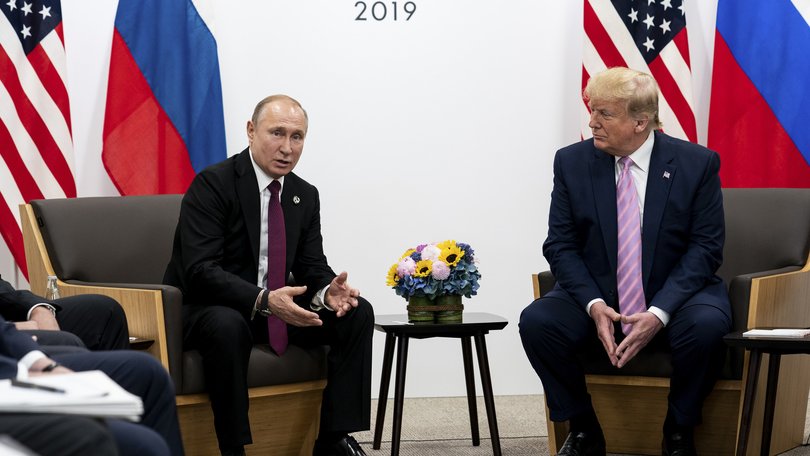THE NEW YORK TIMES: Why Donald Trump wants to meet Vladimir Putin

There is nobody with more confidence in President Donald Trump’s dealmaking abilities than Mr Trump himself.
Yet, as his Friday meeting in Alaska with President Vladimir Putin of Russia draws near, he and his top aides are lowering expectations, suggesting it’s not Mr Trump’s job to make peace between Moscow and Ukraine and calling the summit little more than a “listening exercise.”
Statements like that belie the enormous stakes of the first meeting between Mr Trump and Mr Putin since the Russian invasion, particularly for the parties who aren’t expected to be present, which includes the leadership of Ukraine and of the European nations that have been living with the war on their doorstep. For Mr Trump, though, the motivation is personal — it’s a chance to reset a relationship he has long boasted about but has lately become rocky, while bringing his personal brand of dealmaking to the world’s biggest stage.
Sign up to The Nightly's newsletters.
Get the first look at the digital newspaper, curated daily stories and breaking headlines delivered to your inbox.
By continuing you agree to our Terms and Privacy Policy.There’s a lot going on here. So I called David Sanger of The New York Times, who has covered the White House and national security for decades and who has written books about superpower conflict, before he boarded a series of flights to Anchorage.
He walked me through the calculus of risk and reward around this meeting — and why Mr Putin can claim a modest win before it even starts. (Our conversation was condensed and edited for clarity.)
Q: As you’ve written, it used to be normal for an American president to meet with the Russian leader. George W. Bush met with Putin roughly two dozen times. Joe Biden met him only once, in 2021. But Trump’s meeting will be the first for an American president since the Western world isolated Russia following the invasion of Ukraine. What does he stand to gain from it?
A: Trump sees himself as a peacemaker, and this is tied up very much in his oft-expressed desire to win the Nobel Peace Prize, which he usually combines with some kind of comment to suggest that the Nobel committee would never give it to him.
He has taken credit for a ceasefire between India and Pakistan, although the Indians have a different version of that story. He took a direct role in a peace pledge signed between Armenia and Azerbaijan, at the White House, and there have been other regional conflicts in which he’s played an important role. The big ones, though, have evaded him.
Those, of course, are the Israel-Hamas war and the Russian war with Ukraine, which he famously declared that he would solve in 24 hours, on the basis of his long and, in his view, respectful relationship with Putin. He has now come to question whether that relationship is what he thought it was, or at least what he portrayed it as, because Putin has held a series of perfectly friendly, constructive phone calls with him and then continued on the same battle plan that he was on before, with considerable recent success.
If the president comes out of Alaska without an immediate or imminent ceasefire plan, I think it’s going to be difficult for him to portray this as a win. But a ceasefire alone won’t be enough.
Q: Who has the most at stake here?
A: The country with the most at stake, of course, is Ukraine and its president, Volodymyr Zelensky, who wasn’t invited. The second-most at stake is President Trump and the countries that make up the North Atlantic Treaty Organization, or NATO. Let me explain.
For Ukraine, the risk is that Trump will push for something he’s been referring to as a “land swap.” He doesn’t say that Russia would simply get the land that it has already taken militarily, which would be problematic enough, because it would reward Moscow and Putin for invading a sovereign state.
Trump’s use of the phrase “swaps” leaves you with the impression that he might be willing to award the Russians territory that they have not gained militarily, in return for something else.
Q: Tell us about the risks for Trump.
A: The big risk for Trump is that whatever comes out of Alaska is just a delaying action. Putin may calculate that what he needs most is a relaxation of sanctions, a reopening of trade and time to rebuild his force so that a few years from now, he can attempt a reinvasion of the rest of Ukraine and use the territory he’s gained as a launchpad to drive toward Kyiv. That’s a huge risk, and the Ukrainians are rightly worried about it.
To forestall that, the Europeans and Zelensky are insisting on security guarantees and continued arms shipments to Ukraine, as well as making sure that Trump doesn’t make any concessions about where NATO forces can be deployed in Eastern Europe. All of those issues are as important — and over the long term, perhaps more important — than where you draw the boundaries between Russia and Ukraine.
And there’s one more risk for NATO. Will Putin use this meeting to drive a wedge between Trump and the NATO allies? That is Putin’s greatest dream.
Q: The person who has the least to lose from this meeting, it seems, is Putin himself. What might he be trying to extract?
A: Putin has something of a victory just the moment that he lands in Alaska, because it’s the end of his isolation by the West.
He’s most certainly thinking about ways to raise topics that will distract Trump from the war in Ukraine. He’s bringing a business delegation, and while we don’t know what they are prepared to discuss, there’s no better way to get Trump’s attention than wave a big possible investment deal, particularly for critical minerals or rare earths that would make the US less dependent on China.
There’s also the possibility that Putin will offer up some kind of informal agreement to extend the last major bilateral arms control treaty between Russia and the United States, which expires early next year. That could allow Trump, who is very sensitive on nuclear issues, to walk away claiming a win.
Q: For Trump, this exercise is about him saving face over his up-and-down relationship with Putin. It’s about burnishing his credentials as a peacemaker. It’s about making himself look good. And yet it comes with great, great geopolitical risk for traditional American allies.
A: It does. And a lesson that we learned from the first Trump term is that the President tends to go into these meetings under-prepared and overly confident in his ability to use the force of personality to win the day.
Let’s think of the biggest example in the first term. It was his personal diplomacy with Kim Jong Un of North Korea. But where are we now? The two leaders embraced each other and exchanged lovely letters, but never reached a nuclear agreement. North Korea has more nuclear weapons today than it ever had, by far, during Trump’s first term.
Just because you’re holding the meeting and all the cameras are there and handshakes and hugs are happening does not necessarily mean that you are changing the directional arrow of world events.
Q: Is that the best that Europe and Ukraine can hope for here? That this meeting doesn’t make anything worse for them — it just doesn’t do anything at all?
A: “First do no harm” is not only a medical phrase. It’s also true in the science of — and art of — geopolitics.
This article originally appeared in The New York Times.
© 2025 The New York Times Company
Originally published on The New York Times
